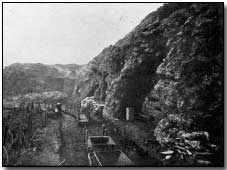Memoirs & Diaries - Account of the Struggle for Fort Douaumont, Verdun, 20-23 May 1916
 Verdun has become a battle of madmen in the midst of a volcano.
Verdun has become a battle of madmen in the midst of a volcano.
Whole regiments melt in a few minutes, and others take their places only to perish in the same way. Between Saturday morning [May 10th] and noon Tuesday [May 23rd] we estimate that the Germans used up 100,000 men on the west Meuse front alone.
That is the price they paid for the recapture of our recent gains and the seizure of our outlying positions.
The valley separating Le Mort Homme from Hill 287 is choked with bodies. A full brigade was mowed down in a quarter hour's holocaust by our machine guns. Le Mort Homme itself passed from our possession, but the crescent Bourrus position to the south prevents the enemy from utilizing it.
The scene there is appalling, but is dwarfed in comparison with fighting around Douaumont. West of the Meuse, at least, one dies in the open air, but at Douaumont is the horror of darkness, where the men fight in tunnels, screaming with the lust of butchery, deafened by shells and grenades, stifled by smoke.
Even the wounded refuse to abandon the struggle. As though possessed by devils, they fight on until they fall senseless from loss of blood. A surgeon in a front-line post told me that, in a redoubt at the south part of the fort, of 200 French dead, fully half had more than two wounds. Those he was able to treat seemed utterly insane. They kept shouting war cries and their eyes blazed, and, strangest of all, they appeared indifferent to pain.
At one moment anaesthetics ran out owing to the impossibility of bringing forward fresh supplies through the bombardment. Arms, even legs, were amputated without a groan, and even afterward the men seemed not to have felt the shock. They asked for a cigarette or inquired how the battle was going.
Our losses in retaking the fort were less heavy than was expected, as the enemy was demoralized by the cannonade - by far the most furious I have ever seen from French guns - and also was taken by surprise. But the subsequent action took a terrible toll. Cover was all blown to pieces. Every German rush was preceded by two or three hours of hell-storm, and then wave after wave of attack in numbers that seemed unceasing.
Again and again the defenders' ranks were renewed.
Never have attacks been pushed home so continuously. The fight for Cemetery Hill at Gettysburg was no child's play, nor for Hougoumont at Waterloo, but here men have been flung 5,000 at a time at brief intervals for the last forty-eight hours.
Practically the whole sector has been covered by a cannonade, compared to which Gettysburg was a hailstorm and Waterloo mere fireworks. Some shell-holes were thirty feet across, the explosion killing fifty men simultaneously.
Before our lines the German dead lie heaped in long rows. I am told one observer calculated there were 7,000 in a distance of 700 yards. Besides they cannot succour their wounded, whereas of ours one at least in three is removed safely to the rear.
Despite the bombardment supplies keep coming. Even the chloroform I spoke of arrived after an hour's delay when two sets of bearers had been killed.
The dogged tenacity needed to continue the resistance far surpasses the furious élan of the attack. We know, too, the Germans cannot long maintain their present sacrifices. Since Saturday the enemy has lost two, if not three, for each one of us. Every bombardment withstood, every rush checked brings nearer the moment of inevitable exhaustion. Then will come our recompense for these days of horror.
Photograph courtesy of Photos of the Great War website
Source: Source Records of the Great War, Vol. IV, ed. Charles F. Horne, National Alumni 1923
In WW1 an "ace" was a pilot who scored five confirmed "kills".
- Did you know?
